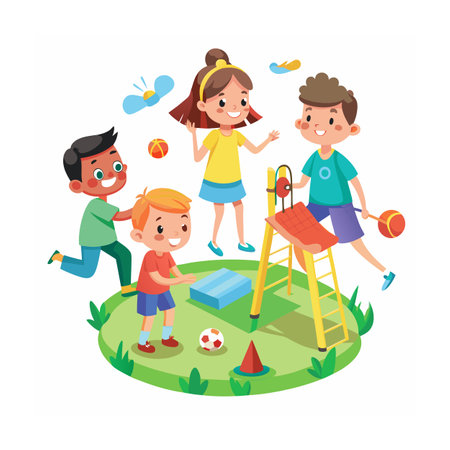Introduction to Feng Shui Symbols in Children’s Rooms
Feng Shui is an ancient Chinese practice that focuses on creating harmony and balance in our living spaces. Over the years, it has become increasingly popular among American families who are looking for ways to improve their homes energy and atmosphere. When it comes to decorating children’s rooms, many parents are curious about how these principles can benefit their kids’ well-being, growth, and happiness.
What Is Feng Shui?
At its core, Feng Shui is about arranging your environment to promote positive energy—often called “chi.” This means using colors, shapes, furniture placement, and symbolic objects to create a space that feels safe and nurturing. In children’s rooms, this can translate into choosing art and décor that inspire comfort, joy, and creativity.
Why Is Feng Shui Popular in the U.S.?
Parents across the United States are increasingly drawn to holistic approaches when it comes to raising their children. The idea of using design and symbolism to encourage better sleep, calmness, and confidence appeals to moms and dads looking for natural ways to support their kids. Plus, Feng Shui’s focus on order and positivity aligns with many American values around home life and parenting.
Reasons Parents Use Feng Shui in Kids’ Spaces
| Reason | Description |
|---|---|
| Promote Good Sleep | Arranging furniture and choosing calming symbols may help children relax at bedtime. |
| Boost Confidence | Certain images or art can encourage feelings of safety and self-assurance. |
| Create Harmony | A balanced room layout helps reduce stress and arguments between siblings. |
| Encourage Learning | Symbols that represent wisdom or knowledge can inspire curiosity. |
| Add Personal Touch | Customizing décor with meaningful objects makes kids feel loved and supported. |
The Basics of Using Feng Shui Symbols
When starting with Feng Shui in your child’s room, begin by observing the space: Is there enough light? Are there cluttered areas? Do the decorations feel cheerful? Then think about what symbols or artwork might suit your child’s age, interests, and needs. From animal prints to nature-inspired pieces, there are plenty of options that fit both traditional Feng Shui ideas and modern American tastes.
Looking Ahead: Blending Traditions with Modern Décor
As more parents discover the benefits of Feng Shui symbols in children’s room décor, they’re finding creative ways to blend Eastern wisdom with Western style. Whether you’re completely new to this practice or just curious about adding a few positive touches, understanding the basics is a great first step in designing a nurturing space for your child.
2. Common Feng Shui Symbols and Their Meanings
When decorating a child’s room with Feng Shui in mind, American parents might be curious about the traditional symbols often used and what they mean. Many Feng Shui elements are believed to bring positive energy, protection, and good fortune. Let’s explore some of the most popular symbols you may want to consider for your child’s space.
Popular Feng Shui Symbols for Children’s Rooms
| Symbol | Traditional Meaning | How It Can Benefit a Child’s Room |
|---|---|---|
| Dragon | Strength, courage, protection | Adds a sense of safety and confidence; can inspire bravery and creativity |
| Phoenix | Rebirth, hope, new beginnings | Encourages resilience and optimism; ideal for children facing changes or challenges |
| Fish (Koi or Goldfish) | Abundance, prosperity, luck | Promotes positive vibes and a sense of well-being; often linked to educational success |
| Tortoise/Turtle | Stability, longevity, protection | Helps create a calming atmosphere and supports steady growth and development |
| Lucky Bamboo | Growth, flexibility, good fortune | Adds natural beauty and represents healthy development in life and learning |
| Double Happiness Symbol | Joy, harmony, positive relationships | Great for siblings sharing a room or encouraging friendships; fosters emotional balance |
Choosing Symbols for Your Child’s Room: Practical Tips for American Families
- Keep it playful: Use these symbols in the form of artwork, plush toys, or wall decals that fit your child’s style.
- Avoid anything scary: Choose friendly-looking dragons or gentle phoenix images—nothing too intense for young kids.
- Cultural respect: Share the story behind each symbol with your child so it feels meaningful, not just decorative.
- Simplicity is key: One or two well-chosen symbols are usually enough for a balanced space.
- Combine with American themes: It’s perfectly fine to blend these symbols with popular American kids’ décor like stars, animals, or favorite colors.
Where to Place Feng Shui Symbols in a Child’s Room?
The placement of these symbols can enhance their effect. For example:
- Near the bed: Place protective symbols like the dragon or turtle by the headboard for added comfort at night.
- On study desks: Fish motifs can inspire focus and success in schoolwork.
- Shelves or windowsills: Lucky bamboo looks great here and brings fresh energy into the space.
Making Feng Shui Fun and Personal for Kids
You can involve your child by letting them pick which symbols they like best. Let them help choose where to display artwork or decorations—it makes Feng Shui feel special and personal!

3. How to Select Child-Friendly Feng Shui Art and Décor
Decorating a child’s room using Feng Shui principles can be a fun and meaningful way for American parents to create a nurturing space. When selecting art and décor, it’s important to focus on items that are both age-appropriate and respectful of cultural backgrounds while also fitting with the tastes and values common in American families. Here’s how you can make thoughtful choices:
Age-Appropriate Choices
Children’s rooms should feel safe and joyful. Choose symbols and artwork that are simple, colorful, and positive. Avoid sharp or scary imagery, as well as anything too complex for your child’s age group. Friendly animals, gentle nature scenes, and cheerful colors are great options.
| Age Group | Recommended Feng Shui Art & Décor |
|---|---|
| Toddlers (1-3) | Soft animal plushies, pastel wall decals of clouds or rainbows, gentle night lights with natural motifs |
| Preschool (4-6) | Bright wall art featuring birds or trees, playful mobiles, nature-inspired bedding |
| Elementary (7-12) | Inspirational quote posters, framed landscape prints, crystal suncatchers for windows |
Culturally Sensitive Selections
Feng Shui is rooted in Chinese tradition, but you can blend its principles with American culture by focusing on universal themes like harmony, growth, and happiness. When choosing symbols such as dragons or koi fish, consider their meaning and opt for stylized or cartoon versions that are friendly for kids. Avoid religious or sacred icons unless they align with your family’s beliefs.
Blending Cultures: Example Décor Ideas
- Panda bear plushies (Chinese symbol of peace) alongside classic American teddy bears
- Paper lanterns in primary colors for festive lighting
- Nature posters that combine elements from local parks and Asian gardens
Visually Appealing for Kids
The best Feng Shui décor will attract your child’s attention without overwhelming them. Look for soft textures, rounded shapes, and calming colors like blues and greens mixed with pops of yellow or pink. Involve your child in picking out items—they’ll enjoy having a say in their own space!
Checklist for Choosing Feng Shui Art & Décor:
- Is it made from safe, non-toxic materials?
- Does it feature positive imagery?
- Will it fit comfortably in the room without cluttering the space?
- Is it easy to clean or maintain?
- Does your child like it?
By keeping these tips in mind, you’ll be able to create a balanced and inviting room that reflects both Feng Shui wisdom and your family’s unique style.
4. Placement Tips: Creating a Balanced and Positive Space
When decorating a childs room with Feng Shui symbols and art, placement is just as important as the items themselves. By following some simple guidelines, American parents can ensure their child’s space feels safe, comfortable, and balanced—without clashing with modern home standards.
Key Placement Principles for Children’s Rooms
| Feng Shui Symbol or Art | Best Placement | Why It Works | American Home Tip |
|---|---|---|---|
| Animal Images (e.g., turtles, fish) | Near study desk or on shelves at eye level | Promotes wisdom and calmness; not overwhelming when kept visible but subtle | Avoid large wall murals that may feel too busy for small rooms |
| Nature Scenes (mountains, water, trees) | Opposite the bed or beside a window | Adds a sense of growth and stability; natural light enhances positive energy | Choose prints or canvases to match room colors and avoid overstimulation |
| Inspirational Words or Characters (like “Peace” or “Love” in Chinese calligraphy) | Above the headboard or on a main wall | Encourages positive thinking and emotional support during sleep and playtime | Select clear, easy-to-read fonts to blend with typical American décor styles |
| Lucky Bamboo or Plants (real or artificial) | On a dresser or window sill, away from direct traffic paths | Presents growth and good health; greenery soothes and purifies the air (if real) | If using real plants, ensure they are non-toxic and safe for children/pets |
| Family Photos in Round Frames | On bedside tables or wall shelves close to the child’s bed | Round shapes symbolize unity and safety; family photos offer comfort and security | Avoid glass frames within reach of very young children for safety reasons |
General Placement Do’s and Don’ts
Do:
- Create Symmetry: Try to balance art and symbols on both sides of the room to avoid a lopsided feel.
- Keep It Simple: Less is more. Too many symbols can clutter the space and overwhelm your child.
- Use Soft Colors: Choose gentle hues for frames and backgrounds to create a calming environment.
- Cater to Your Child’s Age: Pick symbols appropriate for your child’s developmental stage—avoid complex images for toddlers.
- Ensure Accessibility: Place favorite symbols where your child can see them daily, but out of reach if fragile.
Don’t:
- Avoid Sharp Edges: Steer clear of pointed frames or decorations that could pose safety risks.
- No Over-the-Bed Hangings: Don’t hang heavy artwork directly over your child’s bed—choose lightweight options if you must decorate above the headboard.
- No Mirrors Facing the Bed: In Feng Shui, mirrors reflecting the bed can disrupt restful sleep; keep them elsewhere in the room.
- Avoid Dark Corners: Place symbols where natural light can reach them—dim corners can collect stagnant energy.
- No Clutter Under Beds: Keep under-bed spaces clean to promote healthy energy flow throughout the room.
Simplifying Feng Shui for American Homes
You don’t have to follow every traditional rule to benefit from Feng Shui in your child’s room. The key is blending these principles with American standards of safety, comfort, and style. By thoughtfully choosing where and how you display meaningful symbols and art, you’ll create an uplifting space where your child can thrive.
5. Cultural Sensitivity and Practical Considerations
When decorating a child’s room with Feng Shui symbols and art in the United States, it’s important for parents to balance cultural respect with their own family’s traditions and style preferences. Here are some key points to consider:
Understanding Cultural Origins
Feng Shui is deeply rooted in Chinese culture, with each symbol carrying specific meanings. American families may come from diverse backgrounds, so it’s important to take time to learn about the origins and significance of the items you use. This not only avoids misrepresentation but also teaches children about respecting different cultures.
Example: Common Feng Shui Symbols and Their Meanings
| Symbol | Meaning | Tips for Use |
|---|---|---|
| Dragon | Protection, strength | Place on a shelf or wall for positive energy |
| Bamboo | Growth, resilience | Use real or artwork bamboo in corners of the room |
| Koi Fish | Success, perseverance | Add as prints or figurines near study areas |
| Laughing Buddha | Joy, abundance | Display in a visible area but avoid placing on the floor |
Sourcing and Authenticity Tips
- Choose Reputable Sellers: Look for shops or online stores that specialize in authentic Feng Shui products.
- Avoid Cultural Appropriation: When possible, purchase from businesses that support Asian artisans or communities.
- Quality Over Quantity: A few meaningful pieces often work better than cluttering the room with many unrelated symbols.
- Ask Questions: Don’t hesitate to ask sellers about the meaning and origin of items before buying.
Blending Styles for American Homes
You can honor Feng Shui principles while maintaining your familys unique sense of style. Many American parents blend traditional symbols with modern design elements or colors their children love. Here’s how you can mix styles seamlessly:
| Feng Shui Element | American Décor Style Tip |
|---|---|
| Bamboo Plants | Add to minimalist or Scandinavian-style rooms for a fresh look |
| Koi Art Prints | Select playful colors to match existing wall themes |
| Lucky Cat Figurine (Maneki Neko) | Pair with animal-themed décor commonly found in U.S. nurseries |
| Phoenix Motif Pillowcases | Combine with superhero or fantasy bedding sets popular in America |
Key Takeaways for Parents
- Respect cultural meanings when choosing Feng Shui symbols.
- Select authentic pieces from reputable sources.
- Create a balanced look by mixing traditional symbols with your child’s favorite colors and themes.
- Use Feng Shui as an opportunity to teach children about diversity and respect for all cultures.
By being mindful of both cultural origins and your familys personal style, you can create a beautiful, meaningful space where your child feels happy and inspired.


